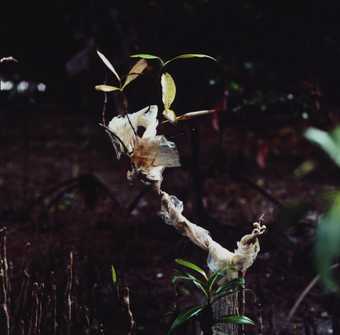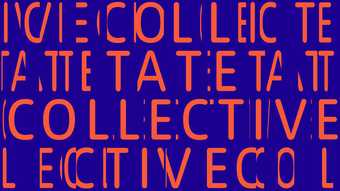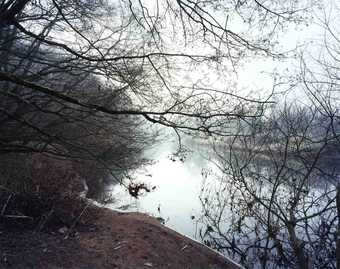Tasha Pick on Channel #15
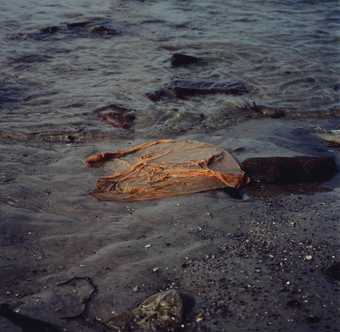
Simryn Gill
Channel #15 (2014)
Tate
Residence Time
Residence time is the time it takes to enter and leave an ocean.
Washed up, washed out, washed away. I look at the thinned skinned orange plastic clinging to sand. A sad sack. Hah. A message in a bottle to a system on the edge of break down
or was it break up. Water-logged, puddled in an ocean that won’t let go. Water and plastic and sand clutch each other in a jealous embrace. A watery caress becomes a tug that says you couldn’t leave me if you tried. A tug becomes an escape that says this is where I leave you, this is where you get off.
Orange plastic quietly seeps into water. It was always a toxic relationship, anyway. Did I ever tell you that North American breast milk also harbours
‘mercury, lead, benzene, arsenic, paint thinner, phthalates, dry-cleaning fluid, toilet deodorizers, Teflon, rocket fuel, termite poison, fungicides, and flame retardant’.
And that in our daily liquid acts – sweating, crying, breathing, lactating, bleeding, menstruating, urinating, digesting – we blur the edges of our bodies. I look again at the orange carcass, forebear and inheritor
creased and weathered as the sea that birthed it, burped it, secreted it. Under water we are in touch with ancestors, with ourselves as already ancestors. On a Saturday afternoon, my grandmother returns with three orange Sainsbury’s bags. She heaves them onto the counter with lined fingers. Unladen, one catches a breeze. It flies over the roof, over the garden fence, through Camden, south, south. A dejected balloon, drifting onto the murky surface of the Thames.
The quotation was taken from Astrida Neimanis' Hydrofeminism: Or, On Becoming a Body of Water (2012).
Nora Selmani on Channel #22

Simryn Gill
Channel #22 (2014)
Tate
Channel #22
After Simryn Gill
This is the place
where our worlds meet.
Leaves slip in
and out of the white light
like an old dream rising up
to greet memory.
Stalks curl upwards
pushing through the black earth:
young fingers gnarled & accusing.
The air is thick with
a language we do not know
how to speak
& all which has been
determined as known
is undone here.
Scraps of red
wrapped around brittle bark
raise the alarm.
A spectre with a knotted heart
waits at the threshold, arms outstretched
to embrace and dance wildly in the beyond, beyond.
Sophie-Aude Boily Thériault on the Channel series
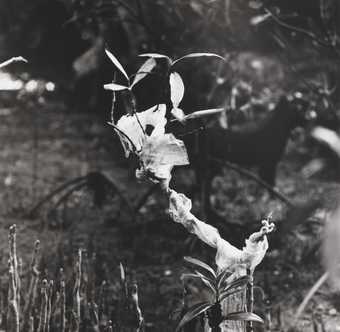
Simryn Gill
Channel #4 (2014)
Tate
There’s a phrase that stands out in Olivia Laing’s Funny Weather (2020): 'What’s the relationship between art and disaster?' What does it mean to create a world when the world is crumbling around us? It’s a question worth pondering, and one I did dwell upon often in my art history classes. While a sixteen-year-old girl was striking for the climate, refusing to attend classes in the name of something much bigger, I found myself being asked to memorize the Blue and Rose periods of an artist whose misogyny proves more salient that his abstract cubism to many of my generation, wondering: what’s the use of all this? When disaster strikes, as it did this summer in California, as it did in spring in Bangladesh, as it did for a lot of us in March, do people really turn to art? More to the point, what bearing does art possess on a world on the brink of collapse?
The answer, if it exists, will not come by looking at Picasso's Les Demoiselles d’Avignon 1907, which, ostensibly, can offer no more than mere escapism. It begins to form, however, in Simryn Gill’s Channel 2014 series, shot in Port Dickson, Malaysia. There, we meet waves engulfing ancient roots, and remnants of man-made objects stuck to trees older than us, hanging off their branches like socks on a washing line. In Channel #4, plastic intertwines with vegetation, one and the other becoming the same, for we, and that which we make, have become an integral part of this landscape. Anthropocene indeed. If to create is to leave a trace, then who’s the artist here- the photographer, or the tourists arriving by the boatload to enjoy the nearby beaches?
Art classes can teach you about composition and lightning, but the eye need not be trained to appraise Channel. Its power resides there - in how it shouts, in a way few artworks manage to: do not look away. There are a million ways to forget our dire predicament, but looking at Channel #5 is not one of them. There lays the relationship between art and disaster. Art, perhaps solely, can bring home so effectively the severity of things. It is its power and its duty. From these photographs it becomes apparent that art must go further that documentation. It is no longer enough to imply ‘look at what we are doing.’ Now artists must, as Gill does, take it upon themselves to make the audience wonder: ‘and what am I doing?’
There’s a certain banality to the perennial question of art’s rationale, and yet as the previously solid conditions of our world begin to tumble, we must turn to it again. How does art respond to disaster? Does it merely reply, or does it incite insurgence? A demand for a new type of art is emerging. One that speaks to the needs of this moment – our need to see, and, more importantly, our need for a reckoning. Art like Channel.
Tallulah Griffith on Channel #1
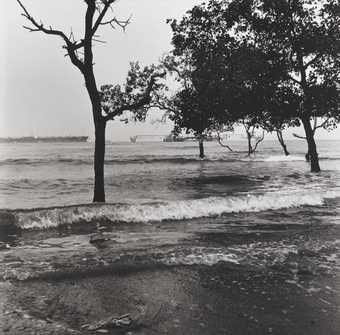
Simryn Gill
Channel #1 (2014)
Tate
Choppy channel hopping. Onlookers, wading through radio waves, lapping up on land. Ch. Ch. Chhhh. Flip the channel, cross the channel. What’s on the other channel? Disaster, every channel, news of the unwanted rolling up on our shores, wetbacks creeping and clambering across the finish line. Run-off runaways, here to overrun the land. Unwanted, inconvenient. Channel one, channel won. Your own fault, they say. Wrecked their home, caused some meltdown. Cooked up some devastation in distant lands. Solid forms ungrounded, assets liquefied. Gushing. Made it here. Frothy fingers reach out, pull back, gain ground, retreat. Rippling, rapping fingernails, only a matter of time. A foamy, formless fugitive. Waves, waving, drowning. Locals suspicious of violent swarms, slippery characters. Whooshing, crashing, background noise building. Close the borders. Where are the borders? Swept away. That neat line dividing earth from water, splitting the elements. Lost at sea. Caps on refugees, thawing, tip of the iceberg. Where to channel thoughts and feelings? Every channel, spitting at the seafoam. Big screen, little screen, stream and stream. Current events. Surf the web. The sound. Media storm, data deluge, flash flood. No one likes change, climate change, they want their country back. Tide after tide of travellers, remaking the contours of the land; the ship the tallest tidal wave, towering and tumbling. Crescent waves like scores of upturned arms, beckoning to those bringing up the rear. Trees jutting out like hands out of a watery grave, fingers crossed. Undo, undo! Round reverse arrow, waves that cancel. Turn the tide, stem the flow. ‘Go back to where you came from!’--gone. There is no backwards, only forwards, onward progress and all that; one way ticket. But now the naysayers’ feet are getting wet, standing in the leak never fixed, ignored, refuted. Hands and feet, dirty, kicking back the newcomers. Denying all responsibility.
Strange: out there in here, world on the doorstep. Shore not sure, all at sea. Trees like bolts of lightning, bolts of silk and cotton unfurling on the coast. Dry land, not so strong and stable anymore. Lost our footing. Island isn’t land. Catastrophe’s out the bag, here to stay, brings so many shades of grey. Melting meeting points, blurred bounds, the world made water. Breathing in and out. Sunshine, strange tongues. Fluorescent fish bearing battle scars, six pack rings refashioned as ruffles, rainbow scales like petrol puddles; adapting, evolving, surviving. Hybrid creatures emerge from the rubble, saplings like water babies wading out, traipsing, lolling, falling. Kids who’ve never seen the sea, ankles newly tickled by spray, jump in puddles, send up confetti. Arms spread wide in alarm and wonder, scratching heads, shrugging, urging each other on. Children who bring the beach home in their hair.
Samantha Dulieu on the Sea Coal, Lynemouth, Northumberland series
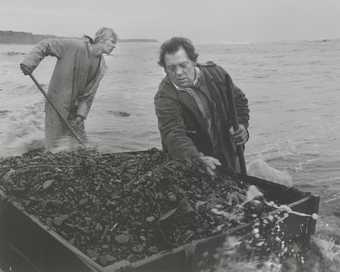
Chris Killip
Brian and unidentified man in the water (1984, printed 2012–13)
Tate
Sturdy hands and coats stiff with salt drag coal from the shore, pulling against a tide that sucks and draws. Coal clings to the beach, dirtying the ground like spilled ink. Coal floats to the grey surface, asking to be turned into supper. Chris Killip’s coal pickers haul the sable rocks into bags and carts, scraping a living from the relics of industrial activity.
The coal seams under the sea-coalers’ feet, Gubeon, Saltwick, Metal, Bentinck, draw fault-lines across a map of the county. The crop of these seams makes fine dust that sits in the crows feet of the lined faces of the men of the towns. A fault-line of history breaks a chasm through these photographs, deindustrialization looms like the stacks in the distance, whispering of a future where coal is not dragged, heaved, and burned.
ndustrialization is palpable, perceptible, volatile. Factories and chimneys erupt from the earth asking to be photographed, a symbol of the new revolution. Deindustrialization is gradual, spread out over too many years to capture on film, except etched on the faces of those flung to the margins when the wealth created by industry, now dampened, seeps from the town.
A few miles north of Lynemouth, coal now lies dormant under the fields that skirt the grassy sand dunes of Druridge Bay. This is the site of a new fault-line, a fight against the sinking of a new pit that would again cleave open the pasture and haul the coal from its seams and crevices. The old fight for survival among the coal has metamorphosed into a fight against it. The people of Northumberland scramble to halt the horse cart that sloshed through the waves at Lynemouth, grinding to a stop the rolled wheel of British mining that has turned for a thousand years.
Friends of the Earth and local protest groups successfully pressured the government to reject permission for the Highthorn open cast pit, which would have seen millions of tonnes of coal extracted over seven years. While Northumberland was at the forefront of the industrial revolution, it can now take its place at the forefront of the drive against fossil fuels.
An industry in its dying embers spat out a last crackle of flame before being stamped down in the courts on the grounds of 'environmental harm' to the landscape. The people of Druridge and Lynemouth have protected their world from once again being choked by the smog that oozes and seeps down the valleys and fields but never quite makes it as far as Westminster.
Simryn Gill’s Channel series was purchased with funds provided by Tate Members, Tate Patrons and Tate International Council in 2018 and works from Chris Killip's series Sea Coal, Lynemouth, Northumberland 1983–4 were purchased with funds provided by the Photography Acquisitions Committee 2014. A selection of these works are on display as part of Photography and the Environment, Tate Modern, from 15 March. Curated by Valentina Ravaglia, Curator, Displays and International Art, Tate Modern.
The Tate Collective Writing Prize is an open call for submission inviting all Tate Collective members to respond to artworks in Tate’s collection. The winning submissions were chosen in collaboration with Tate Collective Producers based in London, Liverpool and St Ives: Arada Banson, Bethany Sewell, Emily Sorrell, Laura Wiggett and Emily Zirong Lyu. Tate Collective is Tate’s membership scheme open to 16–25 year olds worldwide. To find out more visit tate.org.uk/tate-collective. Tate Collective is supported by Jean and Melanie Salata with additional support from Garfield Weston Foundation, The Rothschild Foundation, and Tate Patrons.


